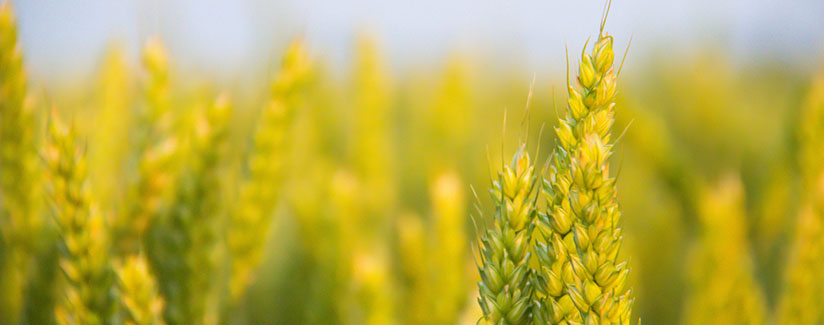
Is Wheat Toxic?
A recent blog post mentioned that a common wheat harvest protocol in the United States is to drench the wheat fields with Roundup® several days before the combine harvesters work through the fields as the practice allows for an earlier, easier and bigger harvest. We wanted to know if this practice is really happening, and if so, why? Does this mean wheat is toxic?
To answer this question, we reached out to:
- Brett Carver, PhD, Wheat Breeding & Genetics, Regents Professor and Wheat Genetics Chair in Agriculture, Oklahoma State University
- Angela Post, PhD, Weed Science Extension, Assistant Professor, Oklahoma State University;
- Jeff Edwards, PhD, Small Grains Extension, Warth Distinguished Professor of Agronomy, Oklahoma State University
Is wheat toxic?
Dr. Brett Carver, Dr. Angela Post and Dr. Jeff Edwards:
Whether in whole form or enriched, wheat is central to a healthy diet for the general population, and should only be avoided by those clinically diagnosed with celiac disease, gluten sensitivity or a wheat allergy. Wheat remains as natural and true to its heritage as any major food-producing plant. Thousands of years of evolution and adoption by human civilizations have made it that way. No other cereal grain claims as much dependency on its ancestors and non-cultivated relatives (what the general population may call ‘ancient grains’) to fuel the development of new and resilient varieties. What is changing are some of the techniques – yet still involving natural pollination – which enable scientists to more efficiently tap those same genetic resources without losing ground to the growing demands of modern society.
Is the protocol for wheat harvest to drench the fields with Roundup several days before harvest?
Dr. Brett Carver, Dr. Angela Post and Dr. Jeff Edwards:
Wheat farmers do not “drench” or “douse” fields with pesticides. Application of any pesticide is expensive to the farmer, who already has a tight bottom line when growing wheat. A glyphosate (the active ingredient in Roundup) application could cost as much as $6.50/acre just for the chemical. For a typical wheat field in the southern Great Plains, that represents an additional $3,500 in costs that the farmer will likely choose not to incur. The common use rate for glyphosate is about one quart per acre. This is equivalent to evenly and accurately spreading one quart of liquid over a football field. Even considering the 10 gallons of water that would be used to dilute the glyphosate for spraying, a more accurate description would be an “extremely light mist” rather than “drench.” This practice might be used occasionally to facilitate wheat harvest and to produce grain that is less contaminated by weeds present at harvest.
For example, in the southern Great Plains and in the southeastern USA, this practice might be used when wet field conditions exist after the wheat has already matured or lost its green color. A mature wheat canopy allows more sunlight to penetrate to the soil surface, setting up a prime environment for summer annual weeds to do what they do best, which is grow at a very rapid rate. Anyone who has hoed weeds from a garden can appreciate how quickly weeds can grow. The green weeds in an otherwise mature wheat field can present harvest problems and/or issues for farmers wishing to immediately plant soybeans after wheat harvest (referred to as double crop). In this case, farmers may choose to apply an herbicide to prevent these summer annual weeds from causing harvest problems. Such problems caused by weeds might include damage to the part of the combine that cuts the crop, increased grain moisture that can cause storage problems, and foreign material or “trash” in the harvested grain.
Also, in some spring wheat (wheat planted in the spring instead of the fall) areas of the northern USA, farmers sometimes use an herbicide such as glyphosate to achieve more uniform drying of wheat plants across the field while controlling weeds. If applied according to label restrictions, these applications would again be made after the crop is considered physiologically mature. That is, the grain is already made, the plant machinery is shutting down, and the plants are simply drying. Estimates we have received say less than one-third of spring wheat acres are treated in this manner. The majority of U.S. wheat acres is grown to winter wheat (wheat planted in the fall), not spring wheat.
Is this a common practice of wheat farmers?
Dr. Brett Carver, Dr. Angela Post and Dr. Jeff Edwards:
No, this is not a common practice of wheat farmers. However, specific situations may call for glyphosate application, as we addressed earlier. A reasonable estimate of the U.S. wheat acreage under this practice would be 0 to 10% in a given year.
Is this practice illegal?
Dr. Brett Carver, Dr. Angela Post and Dr. Jeff Edwards:
No. Many herbicides have labels that allow them to be used as harvest aids or desiccants (helps in drying out the crop). Label guidelines are determined through years of testing and require Environmental Protection Agency (EPA) approval. Glyphosate is labeled for preharvest weed control in scenarios we have described.
Is this practice used to kill regular wheat to dry it out and have an earlier, bigger and easier harvest?
Dr. Brett Carver, Dr. Angela Post and Dr. Jeff Edwards:
This practice is not used to kill wheat, as mentioned above. The wheat is essentially non-living when applications are made. Yield is already determined at this point. Also, all wheat produced commercially for consumption is considered “regular,” and natural.
Should I be worried about this practice when it comes to the health and safety of me and my family?
Dr. Brett Carver, Dr. Angela Post and Dr. Jeff Edwards:
Human health is not at risk when consuming grain produced in this manner or any other manner that is subject to strict regulatory approval of pesticide use.
Does wheat have herbicide residue on it?
Dr. Brett Carver, Dr. Angela Post and Dr. Jeff Edwards:
The grain is not exposed prior to harvest, when the herbicide might be applied, because individual grains are encased by mother plant tissue called the lemma and palea, which, in turn, are encased by the outer glume layer. Think of the glume as an envelope covering the seed, protecting it from the elements and holding it in place until harvest. The threshing process in the combine separates the grain from these maternal tissues otherwise called chaff. Even with whole wheat the chaff is not consumed with the grain.
Our main protection from herbicide residues in food is the EPA’s residue limit set for each commodity where pesticides are likely to be present. In this specific case, EPA does not set a tolerance for wheat flour or other wheat products because glyphosate residues do not concentrate in the grain. To give an example, sweet corn has a residue limit of 3.5 parts per million (ppm), which is the amount of glyphosate allowable on this product at the time of purchase. Studies investigating glyphosate residues on wheat as soon as three days after application recovered 20 times less glyphosate than the EPA allowable tolerance on a food (sweet corn) commonly eaten by consumers.
Are we using herbicides more frequently since the 1980s?
Dr. Brett Carver, Dr. Angela Post and Dr. Jeff Edwards:
No. According to USDA data, total pesticide use in the USA peaked in 1981 and has steadily decreased since. This is true for insecticides, fungicides, and herbicides such as glyphosate. Herbicide use has remained relatively stable since the mid-1990s. Furthermore, the U.S. wheat crop accounts for only 4.5 percent of the total amount of pesticides applied nationwide.
Why is Roundup banned in the Netherlands but not in the U.S.? Is this something to worry about?
Dr. Brett Carver, Dr. Angela Post and Dr. Jeff Edwards:
Glyphosate is not banned in the Netherlands. The Dutch government has passed measures to reduce homeowner use of glyphosate by restricting non-agricultural uses. It is still widely used in the agricultural market of the Netherlands.
Should I avoid eating commercially grown wheat?
Dr. Brett Carver, Dr. Angela Post and Dr. Jeff Edwards:
Commercial supplies of wheat grain are subject to government regulations extending from the farm to the storage facilities and into the bakery. This intense level of scrutiny is intended to give us, as consumers, the confidence we need to enjoy, and not to avoid, one of nature’s treasured grains. Avoidance is advised only in the case of a known medical condition linked to digestibility.
“Wheat” by Susanne Nilsson is licensed under CC BY-SA 2.0


























